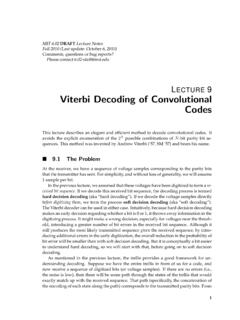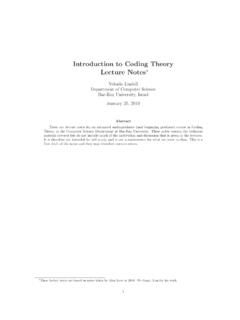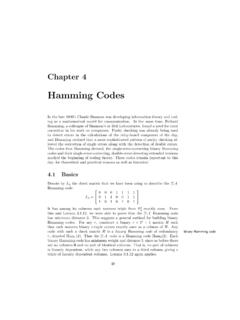Transcription of Detecting and Correcting Errors - MIT
1 Fall 2006 Detecting and Correcting Errors , Slide 1 Detecting andCorrecting Errors Codewords and hamming distance Error Detection: parity Single-bit Error Correction Burst Error Correction Fall 2006 Detecting and Correcting Errors , Slide 2 There s good news and bad good news: Our digital modulation scheme usually allows us to recover the original signal despite small amplitude Errors introduced by the components and example of the digital abstraction doing its job!The bad news: larger amplitude Errors (hopefully infrequent) that change the signal irretrievably. These show up as bit errorsin our digital data Fall 2006 Detecting and Correcting Errors , Slide 3 Channel codingOur plan to deal with bit Errors :We ll add redundant information to the transmitted bit stream (a process called channel coding) so that we can detect Errors at the receiver. Ideally we d like to correct commonly occurring Errors , , error bursts of bounded length. Otherwise, we should detect uncorrectable Errors and use, say, retransmission to deal with the problem.
2 DigitalTransmitterDigitalReceiverChannel CodingErrorCorrectionMessage bitstreambitstream with redundant information used for dealing with errorsredundant bitstreampossibly with errorsRecovered message Fall 2006 Detecting and Correcting Errors , Slide 4 Error detection and correctionSuppose we wanted to reliably transmit the result of a single coin flip:Further suppose that during transmission a single-bit erroroccurs, , a single 0 is turned into a 1 or a 1 is turned into a 0 .01 heads tails Heads: 0 Tails: 1 This is a prototype of the bit coin for the new information economy. Value = Fall 2006 Detecting and Correcting Errors , Slide 5 hamming distance (Richard hamming , 1950) hamming distance : The number of digit positions in which the corresponding digits of two encodings of the same length are differentThe hamming distance between a valid binary code word and the same code word with single-bit error is problem with our simple encoding is that the two valid code words ( 0 and 1 ) also have a hamming distance of 1.
3 So a single-bit error changes a valid code word into another valid code heads tails single-bit errorI wish he dincrease his hamming Fall 2006 Detecting and Correcting Errors , Slide 6 Error DetectionWhat we need is an encoding where a single-bit error doesn t produce another valid code heads tails 0110single-bit errorWe can add single-bit error detection to any length code word by adding a parity bitchosen to guarantee the hamming distance between any two valid code words is at least 2. In the diagram above, we re using even parity where the added bit is chosen to make the total number of 1 s in the code word we correct detected Errors ? Not D is the minimum hamming distance between code words, we can detect up to(D-1)-bit Errors Fall 2006 Detecting and Correcting Errors , Slide 7 Parity check A parity bit can be added to any length message and is chosen to make the total number of 1 bits even (aka even parity ). To check for a single-bit error (actually any odd number of Errors ), count the number of 1 s in the received word and if it s odd, there s been an 1 1 0 0 1 0 1 0 0 1 1 original word with parity0 1 1 0 0 00 1 0 0 1 1 single-bit error (detected)0 1 1 0 0 0 11 0 0 1 1 2-bit error (not detected) One can count by summing the bits in the word modulo 2 (which is equivalent to XOR ing the bits together).
4 Fall 2006 Detecting and Correcting Errors , Slide 8 Checksum, CRCO ther ways to detect Errors : Checksum: Add up all the message units and send along sum Adler-32: two 16-bit mod-65521 sums A and B, A is sum of all the bytes in the message, B is the sum of the A values after each addition. Cyclical redunancy check (CRC)The same circuit is used for both creating and checking the N-bit CRC. When creating the check bits, the circuit accepts the bits of the message and then an N-bit sequence of zeros. The final contents of the shift register (the check bits) will be appended to the message. When checking for Errors , the circuit accepts the bits of the received message (message + check bits, perhaps corrupted by Errors ). After all bits have been processed, if the contents of the shift register is not zero, an error has been Fall 2006 Detecting and Correcting Errors , Slide 9 Error Correction110000 heads tails 100010single-bit error111001101011By increasing the hamming distance between valid code words to 3, we guarantee that the sets of words produced by single-bit Errors don t overlap.
5 So if we detect an error, we can perform error correctionsince we can tell what the valid code was before the error happened. Can we safely detect double-bit Errors while correcting1-bit Errors ? Do we always need to triple the number of bits?If D is the minimum hamming distance between code words, we can correct up to-bit Errors Fall 2006 Detecting and Correcting Errors , Slide 10 Error Correcting Codes (ECC)Basic idea: Use multiple parity bits, each covering a subset of the data bits. The subsets overlap, ie, each data bit belongs to multiple subsets No two data bits belong to exactly the same subsets, so a single-bit error will generate a unique set of parity check errorsD2D1D4D3P1P2P3 Suppose we check the parity and discover that P2 and P3 indicate an error?bit D3 must have flippedWhat if only P3 indicates an error?P3 itself had the error!P1= D1 D2 D4P2= D1 D3 D4P3= D2 D3 Fall 2006 Detecting and Correcting Errors , Slide 11(n,k) Block Codes Split message into k-bit blocks Add (n-k) parity bits to each block, making each block n bits long.
6 How many parity bits do we need to correct single-bit Errors ? Need enough combinations of parity bit values to identify which of the n bits has the error (remember that parity bits can get Errors too!), or to indicate no error at all, so 2n-k n+1 or, equivalently, 2n-k> n Multiply both sides by 2kand divide by n: 2n/n > 2k Most efficient ( , we use all possible encodings of the parity bits) when 2n-k 1 = n (7,4), (15,11), (31, 26) hamming codesMessage bitsParity bitsknThe entire block is called a codeword This code is shown on the previous slide Fall 2006 Detecting and Correcting Errors , Slide 12 What (n,k) code does one use? The minimum hamming distance d between codewords determines how we can use code: To detect E-bit Errors : D > E To correct E-bit Errors : D > 2E So to correct 1-bit Errors or detect 2-bit Errors we need d 3. To do both, we need d 4 in order to avoid double-bit Errors being interpreted as correctable single-bit Errors . Sometimes code names include min hamming distance : (n,k,d) To conserve bandwidth want to maximize a code s code rate, defined as k/n.
7 Parity is a (n+1,n,2) code Efficient, but only 1-bit error detection Replicating each bit r times is a (r,1,r) code Simple way to get great error correction, but Fall 2006 Detecting and Correcting Errors , Slide 13A simple (8,4,3) codeD1D2D3D4P3P4P1P2P1is parity bit for row #1P4is parity bit for column #2 Idea: start with rectangular array of data bits, add parity checks for each row and column. Single-bit error in data will show up as parity Errors in a particular row and column, pinpointing the bit that has the 1 11 1 01 00 1 11 001 0 Parity for each row and column is correct no errorsParity check fails for row #2 and column #2 bit D4is incorrect0 1 11 1 11 0 Parity check only fails for row #2 bit P2is incorrectIf we add an overall parity bit P5, we get a (9,4,4) code! Fall 2006 Detecting and Correcting Errors , Slide 14 Burst ErrorsCorrecting single-bit Errors is nice, but in many situations Errors come in bursts many bits long ( , damage to storage media, burst of interference on wireless channel.)
8 How does single-bit error correction help with that?Well, can we think of a way to turn a B-bit error burst into B single-bit Errors ?BProblem: Bits from a particular codeword are transmitted sequentially, so a B-bit burst produces multi-bit : interleave bitsfrom B different codewords. Now a B-bit burst produces 1-bit Errors in B different Fall 2006 Detecting and Correcting Errors , Slide 15 Framing Looking at a received bit stream, how do we know where a block of interleaved codewords begins? Physical indication (transmitter turns on, beginning of disk sector, separate control channel) Place a unique bit pattern (sync) in the bit streamto mark start of a block Frame = sync pattern + interleaved code word block Search for sync pattern in bit stream to find start of frame Bit pattern can t appear elsewhere in frame (otherwise our search will get confused), so have to make sure no combination of message bits can accidentally generate the sync pattern (can be ) Sync pattern can t be protected by ECC, so Errors may cause us to lose a frame every now and then, a problem that will need to be addressed at some higher level of the communication Fall 2006 Detecting and Correcting Errors , Slide 16 Summary: example channel coding steps1.
9 Break message stream into k-bit Add redundant info in the form of (n-k) parity bits to form n-bit codeword. Goal: choose parity bits so we can correct single-bit Errors , detect double-bit Interleave bits from a group of B codewords to protect against B-bit burst Add unique pattern of bits to start of each interleaved codeword block so receiver can tell how to extract blocks from received Send new (longer) bitstream to Fall 2006 Detecting and Correcting Errors , Slide 17 Summary: example error correction steps1. Search through received bit stream for sync pattern, extract interleaved codeword block2. De-interleave the bits to form B n-bit codewords3. Check parity bits in each code word to see if an error has occurred. If there s a single-bit error, correct Extract k message bits from each corrected codeword and concatenate to form message Fall 2006 Detecting and Correcting Errors , Slide 18 Summary To detect D-bit Errors : hamming distance > D To correct D-bit Errors : hamming distance > 2D (n,k,d) codes have code rate of k/n For our purposes, we want to correct single-bit Errors anddetect double bit Errors , so d = 4 Handle B-bit burst Errors by interleaving B codewords Add sync pattern to interleaved codeword block so receiver can find start of block.
10 Use checksum/CRC to detect uncorrected Errors in Fall 2006 Detecting and Correcting Errors , Slide 19 SLIDES FOR FRIDAYA fter reviewing post lab Fall 2006 Detecting and Correcting Errors , Slide 20In search of a better code Problem: information about a particular message unit (bit, byte, ..) is captured in just a few locations, ie, the message unit and some number of parity units. So a small but unfortunate set of Errors might wipe out all the locations where that info resides, causing us to lose the original message unit. Potential Solution: figure out a way to spread the info in each message unit throughout all the codewords in a block. Require only some fraction good codewords to recover the original Fall 2006 Detecting and Correcting Errors , Slide 21 Spreading the Idea: oversampled polynomials. LetP(x) = m0+ m1x + m2x2+ .. + mk-1xk-1where m0, m1, .., mk-1are the k message units to be encoded. Transmit value of polynomial at n different predetermined points v0, v1, .., vn-1:P(v0), P(v1), P(v2).
















